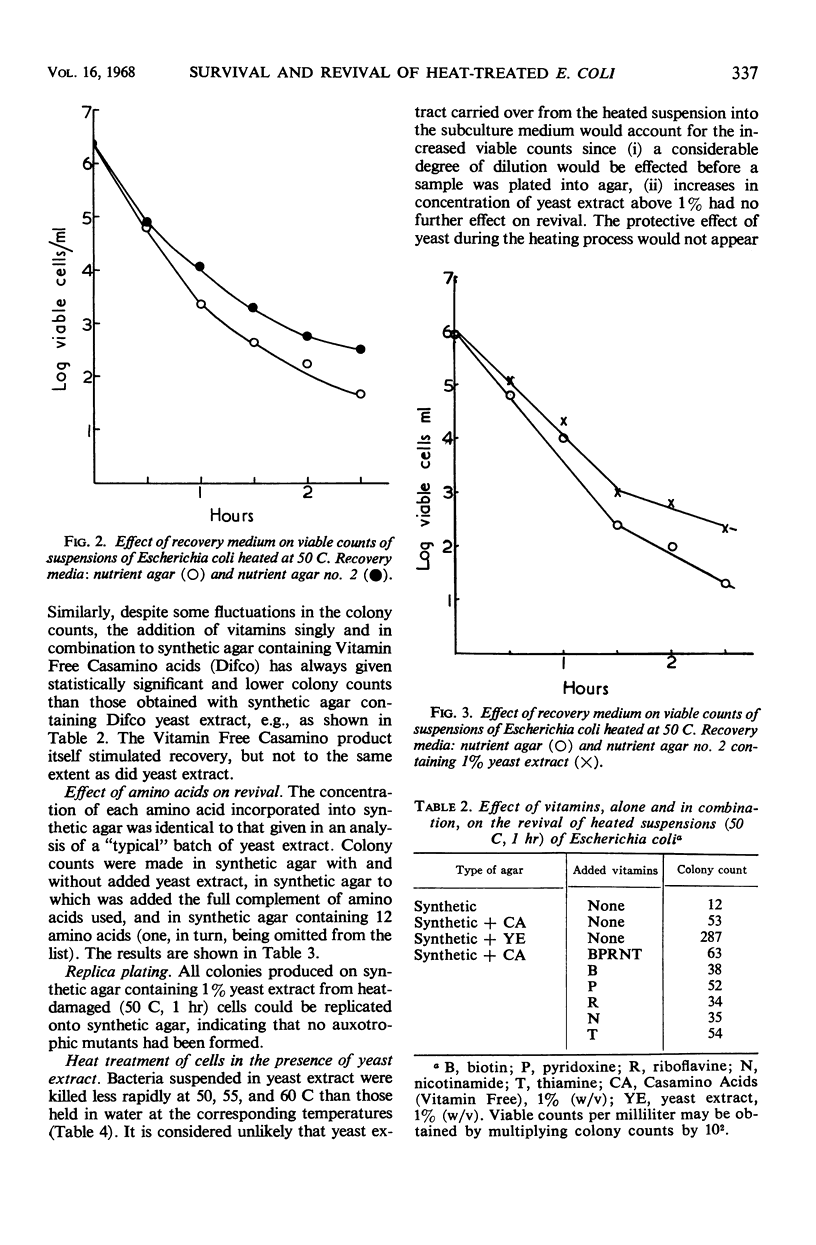Abstract
Maximal revival of heat-damaged Escherichia coli occurred in nutrient media containing 0.8 to 1.0% (w/v) of Difco yeast extract. Vitamins did not appear to be involved in the recovery process. The situation with amino acids was less clear-cut, and, although certain of these may be essential for revival, proof for this is as yet inconclusive. Replica plating, in which colonies (from cells which had survived a heating process) on a rich medium were replicated onto minimal agar, revealed that no auxotrophic mutants had been formed as a result of heat treatment. Bacteria which were heated in 1% (w/v) yeast extract were killed more slowly than those heated in water.
Full text
PDF




Selected References
These references are in PubMed. This may not be the complete list of references from this article.
- ALPER T., GILLIES N. E. Restoration of Escherichia coli strain B after irradiation: its dependence on suboptimal growth conditions. J Gen Microbiol. 1958 Apr;18(2):461–472. doi: 10.1099/00221287-18-2-461. [DOI] [PubMed] [Google Scholar]
- Allwood M. C., Russell A. D. Some factors influencing the revival of heat-damaged Staphylococcus aureus. Can J Microbiol. 1966 Dec;12(6):1295–1297. doi: 10.1139/m66-176. [DOI] [PubMed] [Google Scholar]
- Bairdparker A. C., Davenport E. The effect of recovery medium on the isolation of Staphylococcus aureus after heat treatment and after the storage of frozen or dried cells. J Appl Bacteriol. 1965 Dec;28(3):390–402. doi: 10.1111/j.1365-2672.1965.tb02169.x. [DOI] [PubMed] [Google Scholar]
- Cook A. M., Gilbert R. J. The effect of yeast cells in the heating medium on the heat resistance of Bacillus stearothermophilus spores. J Pharm Pharmacol. 1965 Dec;17:20S–21S. doi: 10.1111/j.2042-7158.1965.tb07736.x. [DOI] [PubMed] [Google Scholar]
- Demain A. L. Amino acid control of ribonucleic acid excretion in Bacillus subtilis. Biochem Biophys Res Commun. 1966 Jul 6;24(1):39–43. doi: 10.1016/0006-291x(66)90406-2. [DOI] [PubMed] [Google Scholar]
- HARRIS N. D., WHITEFIELD M. A LETHAL EFFECT ON DAMAGED ESCHERICHIA COLI ASSOCIATED WITH THE COUNTING TECHNIQUE. Nature. 1963 Nov 9;200:606–607. doi: 10.1038/200606a0. [DOI] [PubMed] [Google Scholar]
- Harries D., Russell A. D. Revival of heat-damaged Escherichia coli. Experientia. 1966 Dec 15;22(12):803–804. doi: 10.1007/BF01897426. [DOI] [PubMed] [Google Scholar]
- LEDERBERG J., LEDERBERG E. M. Replica plating and indirect selection of bacterial mutants. J Bacteriol. 1952 Mar;63(3):399–406. doi: 10.1128/jb.63.3.399-406.1952. [DOI] [PMC free article] [PubMed] [Google Scholar]
- Nelson F. E. Factors which Influence the Growth of Heat-treated Bacteria: I. A Comparison of Four Agar Media. J Bacteriol. 1943 Apr;45(4):395–403. doi: 10.1128/jb.45.4.395-403.1943. [DOI] [PMC free article] [PubMed] [Google Scholar]
- Russell A. D., Harries D. Some aspects of thermal injury in Escherichia coli. Appl Microbiol. 1967 Mar;15(2):407–410. doi: 10.1128/am.15.2.407-410.1967. [DOI] [PMC free article] [PubMed] [Google Scholar]
- STAPLETON G. E., SBARRA A. J., HOLLAENDER A. Some nutritional aspects of bacterial recovery from ionizing radiations. J Bacteriol. 1955 Jul;70(1):7–14. doi: 10.1128/jb.70.1.7-14.1955. [DOI] [PMC free article] [PubMed] [Google Scholar]
- STILES M. E., WITTER L. D. THERMAL INACTIVATION, HEAT INJURY, AND RECOVERY OF STAPHYLOCOCCUS AUREUS. J Dairy Sci. 1965 Jun;48:677–681. doi: 10.3168/jds.s0022-0302(65)88321-7. [DOI] [PubMed] [Google Scholar]
- WILLS B. A. The resistances of vegetative bacteria to moist heat. J Pharm Pharmacol. 1957 Dec;9(12):864–876. doi: 10.1111/j.2042-7158.1957.tb12348.x. [DOI] [PubMed] [Google Scholar]


